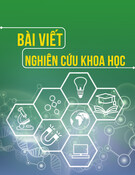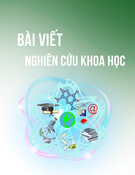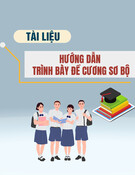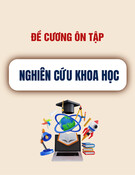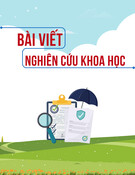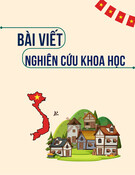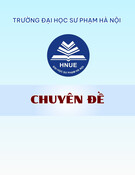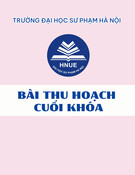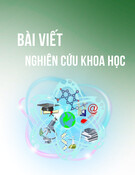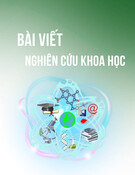
TNU Journal of Science and Technology
229(12): 270 - 278
http://jst.tnu.edu.vn 270 Email: jst@tnu.edu.vn
UTILIZING THE STEM-CIS INSTRUMENT TO EVALUATE THE REALITY
OF STEM CAREER INTERESTS OF 10TH AND 11TH-GRADE STUDENTS OF
SOME HIGH SCHOOLS IN HO CHI MINH CITY, VIETNAM
Quan Minh Hoa1*, Nguyen Thi Kim Anh2, Nguyen Thanh Nga1, Nguyen Lam Duy1
1Ho Chi Minh City University of Education
2National Taiwan University of Science and Technology
ARTICLE INFO
ABSTRACT
Received:
19/6/2024
One of the major priorities of many nations worldwide is to train STEM human
resources to fulfill the demands of the 21st century. Given the potential scarcity
of Vietnam’s STEM workforce, it is vital to ascertain students’ present STEM
career interests to assist them immediately in making a STEM career decision.
Therefore, the research used the STEM Career Interest Survey (STEM-CIS)
instrument to describe the overall picture of STEM career interest through six
social cognitive career theory (SCCT) aspects. The results processed using R
software with the sample of 909 students of 10th and 11th grade studying the
2018 general education curriculum at five high schools in Ho Chi Minh City
(Vietnam) show the relatively high average values of SCCT aspects in STEM
careers of participants, in which the technology field is the highest, the
engineering field is the lowest, and the interest between STEM fields correlates
with each other. Furthermore, gender differences in STEM-CIS for each field
and SCCT aspects are statistically significant, while grade levels are not. These
findings will contribute to orienting the implementation of relevant educational
activities in general or STEM educational activities in particular at high schools
to promote STEM career pathways for Vietnamese students.
Revised:
25/9/2024
Published:
25/9/2024
KEYWORDS
STEM career orientation
Social cognitive career theory
2018 general education
curriculum
High school students
STEM Education
SỬ DỤNG CÔNG CỤ STEM-CIS ĐÁNH GIÁ THỰC TRẠNG HỨNG THÚ NGHỀ
NGHIỆP CỦA HỌC SINH LỚP 10 VÀ 11 TẠI MỘT SỐ TRƯỜNG TRUNG HỌC
PHỔ THÔNG TẠI THÀNH PHỐ HỒ CHÍ MINH, VIỆT NAM
Quản Minh Hoà1*, Nguyễn Thị Kim Ánh2, Nguyễn Thanh Nga1, Nguyễn Lâm Duy1
1Trường Đại học Sư phạm Thành phố Hồ Chí Minh
2Trường Đại học Khoa học và Công nghệ Quốc gia Đài Loan
THÔNG TIN BÀI BÁO
TÓM TẮT
Ngày nhận bài:
19/6/2024
Đào tạo nguồn nhân lực STEM đáp ứng nhu cầu của thế kỉ XXI là một trong
những chính sách ưu tiên hàng đầu của đông đảo các quốc gia trên thế giới. Trong
bối cảnh Việt Nam đối mặt với nguy cơ thiếu hụt nguồn nhân lực STEM trong
tương lai, việc điều tra thực trạng hứng thú nghề nghiệp STEM của học sinh để
kịp thời định hướng lựa chọn theo đuổi nghề nghiệp STEM là điều cần thiết. Do
đó, bài báo sử dụng công cụ STEM Career Interest Survey (STEM-CIS) để mô tả
bức tranh tổng quan liên quan đến hứng thú nghề nghiệp STEM thông qua 6 khía
cạnh của lý thuyết nhận thức xã hội về nghề nghiệp (social cognitive career
theory). Kết quả xử lí bằng phần mềm R với mẫu 909 học sinh lớp 10 và 11 đang
theo học chương trình giáo dục phổ thông 2018 tại 5 trường trung học phổ thông
trên địa bàn thành phố Hồ Chí Minh tại Việt Nam cho thấy giá trị trung bình chung
các khía cạnh lý thuyết nhận thức xã hội về nghề nghiệp STEM của học sinh ở
mức khá, trong đó lĩnh vực Công nghệ là cao nhất, Kĩ thuật là thấp nhất, và hứng
thú giữa các lĩnh vực STEM có mối tương quan với nhau. Thêm vào đó, hứng thú
nghề nghiệp STEM và các khía cạnh lý thuyết nhận thức xã hội về nghề nghiệp có
sự khác biệt mang ý nghĩa thống kê giữa giới tính, nhưng không với khối lớp.
Những kết quả trên sẽ góp phần định hướng triển khai các hoạt động giáo dục nói
chung hay các hoạt động giáo dục STEM nói riêng phù hợp tại nhà trường THPT
trong việc cải thiện định hướng lựa chọn nghề nghiệp STEM của học sinh.
Ngày hoàn thiện:
25/9/2024
Ngày đăng:
25/9/2024
TỪ KHÓA
Định hướng nghề nghiệp STEM
Lý thuyết nhận thức xã hội về
nghề nghiệp
Chương trình giáo dục phổ
thông 2018
Học sinh trung học phổ thông
Giáo dục STEM
DOI: https://doi.org/10.34238/tnu-jst.10635
* Corresponding author. Email: hoaqm.hcmue@gmail.com







